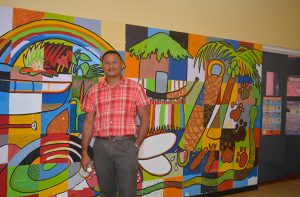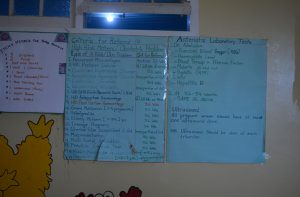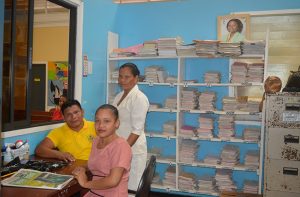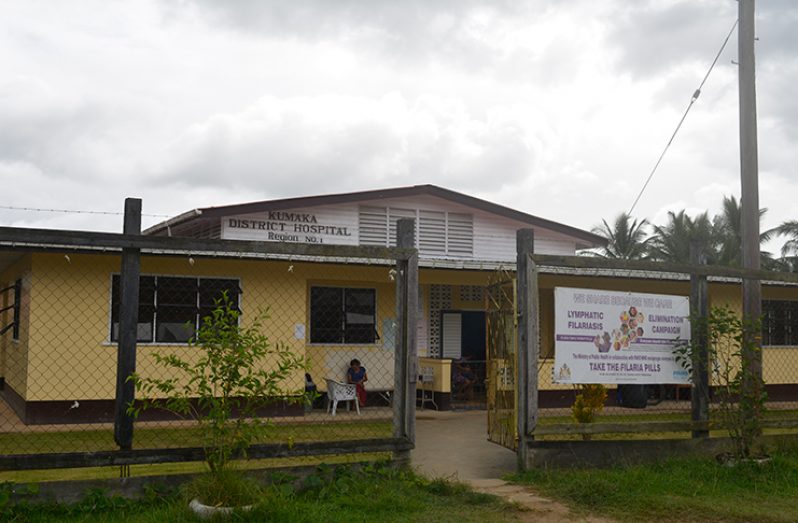THE Kumaka District Hospital headed by doctor-in-charge, Dr Derron Moonsammy, is the only district hospital in the large Moruca sub-region of Region One (Barima Waini), where there are some 11 `satellite’ villages.
It is supported by two health centres located at Waramuri and Kwebana and 14 health posts. The several health posts are spread out as far as Barama, a mining area, and can also be found at locations such as Himarcabra, Santa Cruz, Warapoka, Wycrabi, Kariaco, Coco, Six Miles-Cariburi and Chinese Landing, and are manned by Community Health Workers (CHW).

The facility offers services for every illness including, treating patients who suffer from diabetes, hypertension and asthma, as well as maternal and child-health services for pre and post-natal mothers, among other illnesses.
Electricity in the Moruca sub-region is offered from 05:00 hours to 08:00 hours and from 14:00hours to 22:00 hours daily. The facility has three generators but, according to Dr Moonsammy, the two larger ones are unserviceable, while a smaller one cannot generate enough power for the entire facility. There is, however, discussion to have the hospital outfitted with solar energy, he added.
Assisting Dr Moonsammy at the facility is another doctor and 13 nurses, who are Patient Care Assistants (PCAs), registered nurses, midwives and nursing assistants. With the exception of the doctor and a medex, all of the other staff are from the Moruca sub-region.
The District Hospital also houses a pediatric ward; female and male wards, an observation ward, a maternity ward, delivery room, units where VIA (Visual Inspection with Acetic Acid) for cancer screening is done; VCT ( Voluntary Counseling and Testing for HIV and DOTs (Direct Observation Treatment for Tuberculosis (TB) are conducted. An Audiology department which is part of the rehab–screening for diseases of the ear also part of the facility.
According to Dr Moonsammy, treatment for chronic diseases is offered at a clinic set up in a section of the facility. Another unit for maternal and child health services catering for post and pre-natal mothers occupies space in the vicinity

“It is one of the reasons that we need the MCH (Maternal Child Health) clinic. We need some more personnel. We already have three members of staff who are presently working fulltime in the Maternal and Child Health Department,” he said.
The medex who is in charge of VIA (Visual Inspection with Acetic Acid), the VCT (Voluntary Counselling and Testing (VCT) for HIV and two nurses are shared among other programmes, he noted.
“It is a lot of work and they are unable to give of their full attention to their rightful department,” the doctor added, while making the plug for additional staff.
On a weekly basis approximately six patients are treated for malaria. They are mostly persons who work in the mines. However, the doctor explained that because medication to treat malaria is being sold in the mines, more often than not, those who are ill self-treat themselves. Those who seek medical attention at the hospital, are the ones who have returned from their work sites.
Meanwhile, with his vision for the establishment of a Maternal and Child Health clinic set, Dr Moonsammy says there is need for holistic training as it relates to persons suffering from mental illness. He opined that the target audience for such training should not only be nurses but should include the families of patients, teachers, religious leaders, members of the village council and the police.
Challenges
According to the medical practitioner, no treatment for HIV is done at the hospital as it is not a treatment site, but Dr. Moonsammy expressed the hope that the medical institution will be able to offer the service soonest.
In relation to the power supply, it is not conducive to the proper functioning of a VCT site. It has also affected the vaccination programme at the hospital, as the vaccines are required to be stored at a particular temperature, and without electricity for an hour the vaccines will begin to spoil, Dr Moonsammy explained.

Meanwhile, he sees the need for the hospital to be outfitted with an ultrasound machine, an x-ray unit, a theatre, and a laboratory to bring it up-to-par with modern facilities.
And, with the recent refurbishing of the Bemichi Airstrip to the tune of some $64M, Dr. Moonsammy is of the view that the sub-region will be able to save some much-needed funds. On this note, he recalled some memorable moments, both good and bad, with having to transport patients who were referred to the Suddie Hospital or to Georgetown Hospital, via river to Charity. Additionally, the journey on the Atlantic could be very dangerous.
Meanwhile, most of the residents with whom the Guyana Chronicle spoke while in Moruca, have complained about having to expend much-needed funds when they have to visit the Suddie Hospital in Region Two. They welcome any further upgrade to the institution.
The Barima-Waini sub-region in which the Kumaka District Hospital is located, has limited economic activities as most of the residents depend on farming, fishing and hunting for their daily sustenance.




.png)









